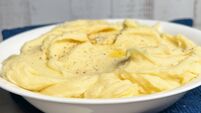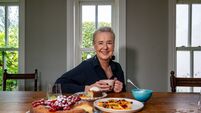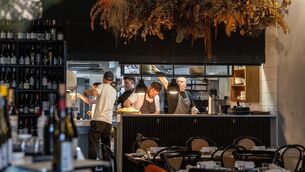How to bake Ruby Bhogal's vegan chai custard creams and sticky Jamaican ginger cake

As a finalist on The Great British Bake Off in 2018, Ruby Bhogal got plenty of experienced bakers keen to help out on her big day. Picture: Matt Russell/PA
Ruby Bhogal might not have a date, venue or dress sorted for her wedding, but one thing’s for certain: the cake is going to be immense.
As a finalist on in 2018 — Rahul Mandal won her season, and she was a runner-up alongside Kim-Joy Hewlett — she’s got plenty of experienced bakers keen to help out on her big day.
“What I do know is I want to have a cake table, [and] there’s no point going on a show like Bake Off if I’m not going to utilise the connections and friends I’ve made on the show,” says Bhogal, who’s engaged to presenter James Stewart.
“I’ve had so many people offering to make a cake for me — I’d be stupid to not say yes.”
Mandal has been “pestering” Bhogal for a date for a wedding “so he can start prepping”, so one thing’s for sure: “The dessert table is going to be absolutely epic.”
Bhogal, 35, even says she will “definitely make one of the cakes”, after recently baking her first-ever wedding cake for her cousin.
She’d turned down plenty of previous offers to bake wedding cakes, saying: “It’s such a huge day. What if something went wrong? I am so clumsy, what if I tripped over my own foot when I was walking in to drop the cake off? I wouldn’t be surprised if that happened, and I literally can’t bear the thought of ruining someone’s day.”
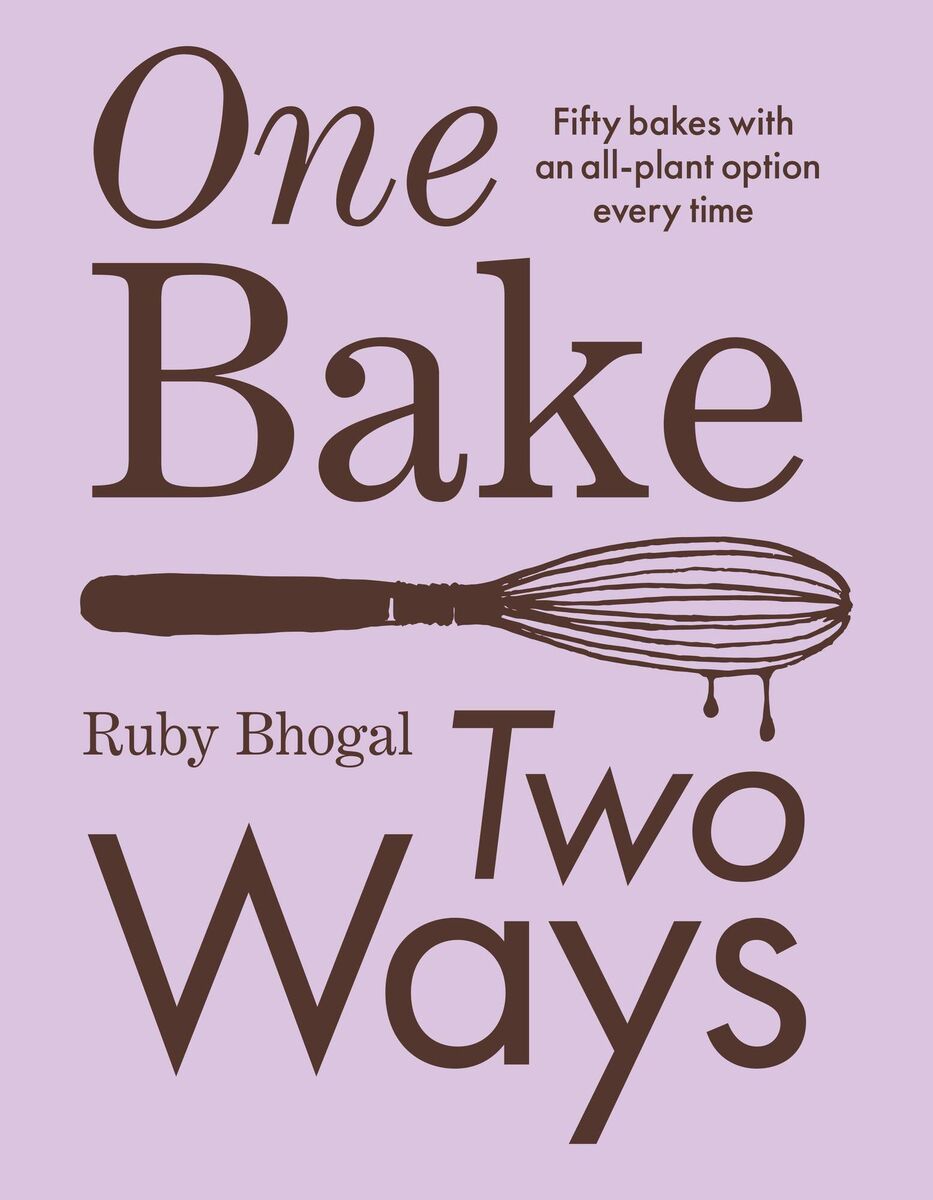
But she changed her mind for her cousin, saying she “couldn’t bear” the thought of someone else making the cake: “No one else is going to put as much care and time and attention into a wedding cake than me.”
Despite an awful lot of prep and a slightly stressful journey transporting the cake from her base in Wandsworth to the Midlands, Bhogal says: “It all went really well. I was surprised at how well it went – to the point where I couldn’t say on social media that actually it was a bit of a breeze, because I think I was more stressed because people were telling me how stressful it was going to be. The outside noise was really getting in my head.”
She ended up making a cardamom sponge cake soaked in cardamom and rose syrup, with raspberry jam and a white chocolate Swiss meringue buttercream — inspired by a recipe in her debut cookbook, .
It’s been six years since Bhogal was on Bake Off, and while many other former contestants have already put multiple cookbooks out, she’s been taking her time — building up her profile in the food industry and appearing on TV shows like and .
The book is full of 50 recipes — from sticky Jamaican ginger cake and salted caramel doughnuts to chai custard creams and banoffee monkey bread — with a regular version next to a completely plant-based variation. Bhogal’s foray into vegan baking might surprise Bake Off fans, who will remember that during Vegan Week on the show, her two-tiered cake dramatically collapsed — in a moment that has since been much-memed, with Bhogal saying: "I literally will never not be haunted by that."
Bhogal isn’t vegan herself, and says of plant-based baking: “I don’t say it lightly when I say it’s a challenge.”
So why did she want to include both vegan and non-vegan bakes in the book? “I grew up in an Indian household and we predominantly ate vegetarian food, then really only ate meat on special occasions. Even now, my mum really only cooks meat on a Saturday, other than that it’s vegetarian food. My sister is the one who is vegan in our family, so we are very much all from mixed diets.
But Bhogal admits that coming up with 100 recipes was an uphill battle, and the cookbook is two years in the making. “People think it’s easy enough to substitute a lot of things,” she says of creating plant-based recipes.
“But what I wanted to make sure was that the substitutions weren’t products you find on the shelves in the supermarket that are full of loads of additives, words you can’t even pronounce and a load of numbers at the end of it. Because if we’re making something from scratch, I want to make sure that it is of good quality.

“Some people think of baking as quite sinful – for me, I think it’s just a way of life. It’s very pleasurable. Food is a very connective thing for me, so I wanted to make sure that what people are consuming is of decent quality, so you won’t find those egg replacers that you’ll find in shops. I tried to opt for lots of natural ingredients instead.”
There were, admittedly, “a lot of failures along the way”, she says – after multiple attempts, Bhogal just can’t crack vegan choux pastry (“it was wild how many times I tried and it just did not work”).
But ultimately, there are plenty of benefits to vegan baking – with Bhogal saying she even prefers plenty of the plant-based variations in the book: “Because it’s somehow lighter, and it’s a lot quicker. You’re also not having to spend a lot of money on eggs – because at the moment, it feels like I need to remortgage every time I go to the supermarket, my God, the cost of ingredients is crazy.”
Because you often don’t have to bother with creaming together ingredients in vegan bakes, Bhogal says: “Often they’re simpler, they bake quicker, and they are lighter in the end result.”
Ruby Bhogal’s vegan chai custard creams
This tasty recipe won’t have you missing eggs or dairy at all.
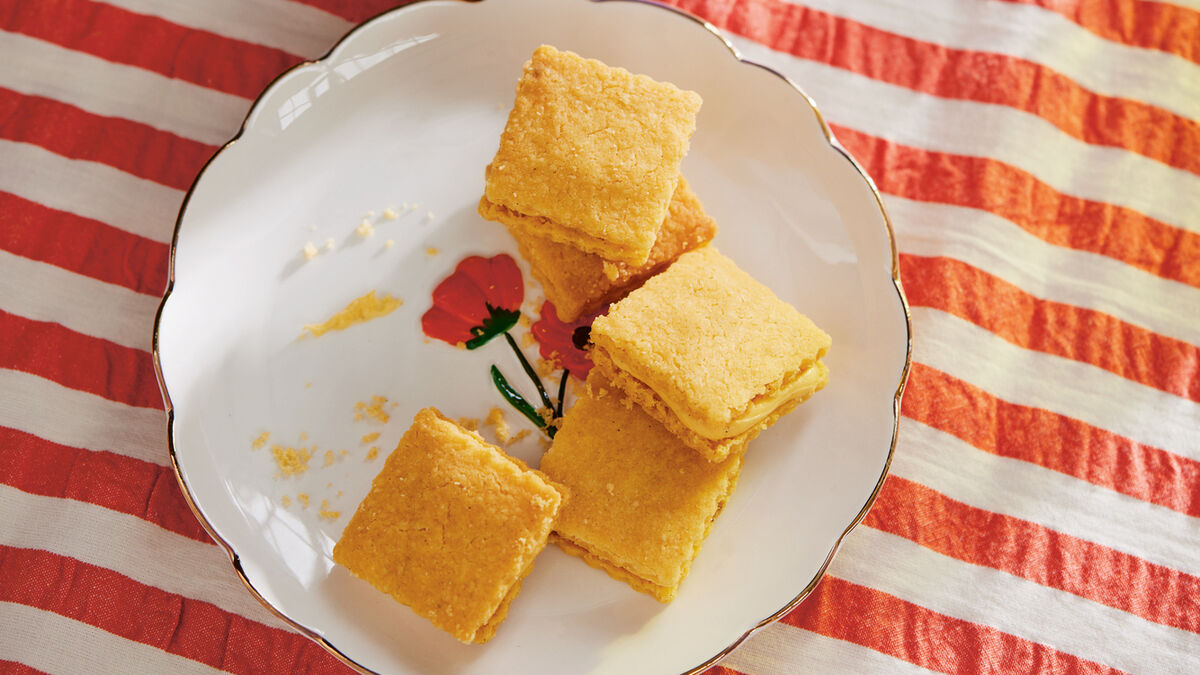
Servings
24Preparation Time
55 minsCooking Time
13 minsTotal Time
1 hours 8 minsCourse
BakingIngredients
275g plant-based unsalted butter, room temperature
115g icing sugar
1tsp vanilla bean paste
200g plain flour, plus extra for dusting
100g custard powder
¾tbsp chai spice mix
For the custard buttercream:
75g plant-based unsalted butter, room temperature
110g icing sugar, sifted
40g custard powder
1tsp vanilla bean paste
1tbsp soy milk
2 baking trays, lined
Method
For the biscuit dough, add the butter and sugar to a bowl and cream together for five minutes until light and fluffy. Add the vanilla bean paste and mix to combine.
In a separate bowl, mix together the flour, custard powder and chai spice mix using a balloon whisk. Add the spiced flour to the butter and mix until just combined.
Lightly flour your worktop and turn out the dough. Use your hands to work the dough and bring it all together once it is soft and smooth. Roughly mould the dough into a disc and press down gently to flatten before wrapping tightly in clingfilm. Pop it in the fridge to chill for 15 minutes.
Remove the chilled dough from the fridge and roll out on a lightly floured silicone mat or sheet of greaseproof paper to about four millimetres thick. Using the cutter of your choice, stamp out the biscuits, and add to the prepared baking trays. Any surplus dough is good to be re-rolled twice, but after this, the dough will begin to toughen, so be savvy with your dough cutting!
Place the trays in the freezer to set for 45 minutes. Preheat oven to 165°C fan/185°C/gas mark 5.
While you are waiting for the biscuits to set, make the custard buttercream. Add all the ingredients, except the soy milk, to a bowl. Use an electric hand whisk or a balloon whisk to combine until smooth. Add the splash of milk at the end to loosen the buttercream, then transfer it to a piping bag.
Once the biscuits have set, pop one tray into the oven and bake for 13 minutes until lightly golden. Repeat with the second tray. Baking them separately just ensures an even bake across both batches.
Leave the biscuits to set and harden on the trays for five minutes before transferring to a cooling rack to cool completely.
When they are completely cool, pipe the custard buttercream onto one biscuit, leaving a slight border around the sides, before sandwiching with another biscuit. Gently press together so the filling comes to the edges. Repeat for all remaining biscuits and filling.
I like these once they have firmed up a little, so I pop my finished biscuits in the fridge for about 30 minutes before dunking and demolishing. Keep these stored with no lid on, to keep that biscuit snap and freshness at its peak
Ruby Bhogal’s cherry and almond pie
This tasty treat works well with any stone fruit – you could even use peaches for a summery spin.
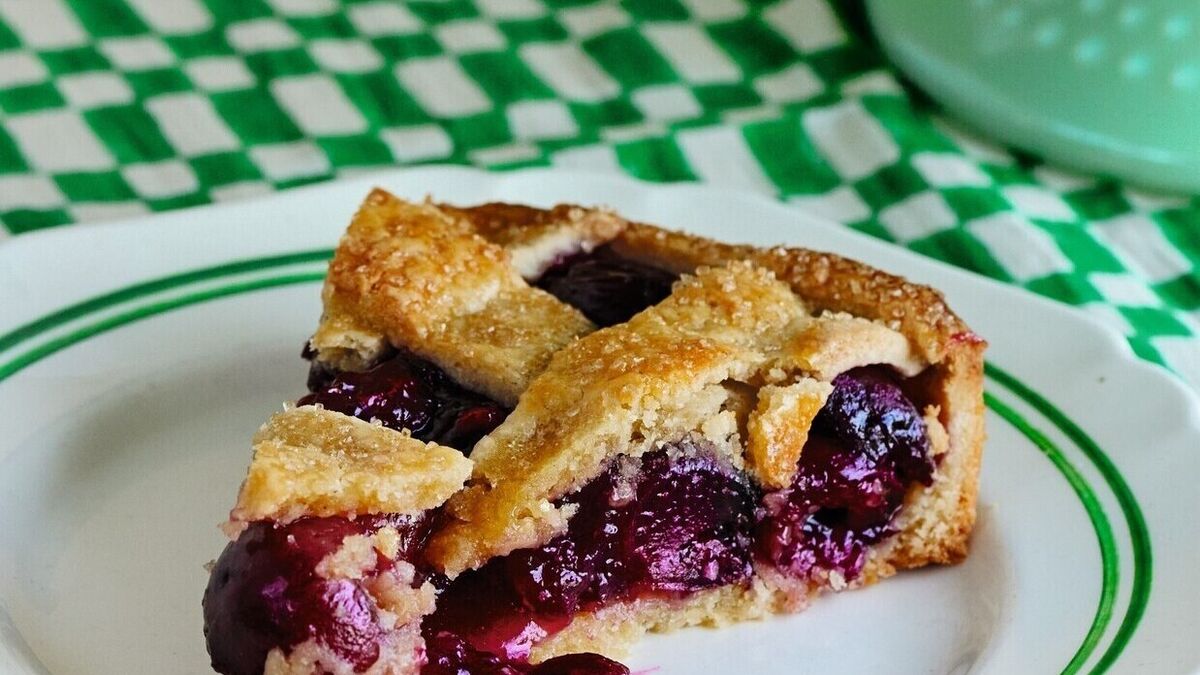
Servings
6Preparation Time
15 minsCooking Time
55 minsTotal Time
1 hours 10 minsCourse
BakingIngredients
For the almond sweet shortcrust pastry:
250g unsalted butter, room temperature
1tsp vanilla bean paste
1tsp almond extract
100g caster sugar
2 medium eggs
200g ‘00’ or plain flour, sifted, plus extra for dusting
200g ground almonds
1 egg, beaten, for brushing
For the cherry filling:
1kg fresh cherries, stoned (you can also use tinned or frozen)
150g caster sugar
30ml freshly squeezed lemon juice
½tsp almond extract
120ml water
35g cornflour, sifted
23-cm/9-in tart tin, buttered
Method
Let’s start with the pastry so this baby can get in the fridge to chill before we do anything else. In a stand mixer or large bowl, add the butter, vanilla bean paste, almond extract and sugar. Mix well until light and fluffy. Add the eggs and mix until fully incorporated. This may take a minute or two to emulsify completely. Next, in goes the flour and ground almonds. Mix until just combined.
Flatten out the dough with your hands on a piece of clingfilm to about one centimetre thickness. Lightly sprinkle with flour and then wrap it tightly and place the covered dough onto a baking tray.
Pop the tray into the fridge to chill for about one hour – this will make it miles easier for you to roll out and handle once the butter has firmed up a notch.
Sprinkle a little flour onto the worktop and use a rolling pin to roll the chilled dough to three millimetres thick. You may find it easier to roll your pastry directly onto some baking paper to prevent any sticking.
Carefully line the base of the prepared tin, gently pressing in the pastry at the base edges before cutting off the excess dough. Keep the surplus dough to one side to use for your top decoration.
Use a fork to gently prick the base of the lined tart tin and place it into the freezer for at least 45 minutes to freeze through completely.
While the tart is in the freezer, make your decorations to top your tart. Whether you choose to lattice, use a stencil, or use cutters, set the decorations aside and place in the freezer to set firm.
Preheat the oven to 170°C fan/190°C/gas mark 5.
Now that everything is chilling, let’s move on to make the cherry filling. In a saucepan, add the cherries, sugar, lemon juice and almond extract. In a bowl, add the water and cornflour and mix to make a slurry. Pour into the saucepan. Place the saucepan over a medium heat and bring to the boil. Reduce the heat and cook the cherries low and slow, stirring often, for about 20 minutes until thickened. Once the liquid has reduced and coats the back of a spoon, remove from the heat and leave to cool. I pour this into a large, shallow baking tray for a speedier cool down.
When the pastry shell is frozen through, scrumple up some greaseproof paper, unfold it and place on top of the base. Pour in some baking beans or dried rice to blind bake for 15 minutes.
Remove from the oven and take out the baking beans (be careful, these will be super-hot!) and greaseproof paper. Use a pastry brush to brush beaten egg liberally over the bottom and sides to seal the pastry and ensure zero soggy bottom. Place back in the oven for a further five minutes to cook the egg wash.
Now spoon the cooled cherry filling into the pie case. Once filled, place your frozen pastry decoration on top and brush with egg wash. Place back into the oven for a further 20 minutes to bake.
Once the pie is out of the oven, allow to cool for 15 minutes in the tin, then carefully remove from the tin before slicing and serving warm. This is also killer when cold and sets nicely for a clean, sharp slice. Either way, fill your plates, fill your bellies. Happy chappy.
Ruby Bhogal’s vegan sticky Jamaican ginger cake
Perfect for anyone who isn’t a chocaholic but still wants a sweet treat.
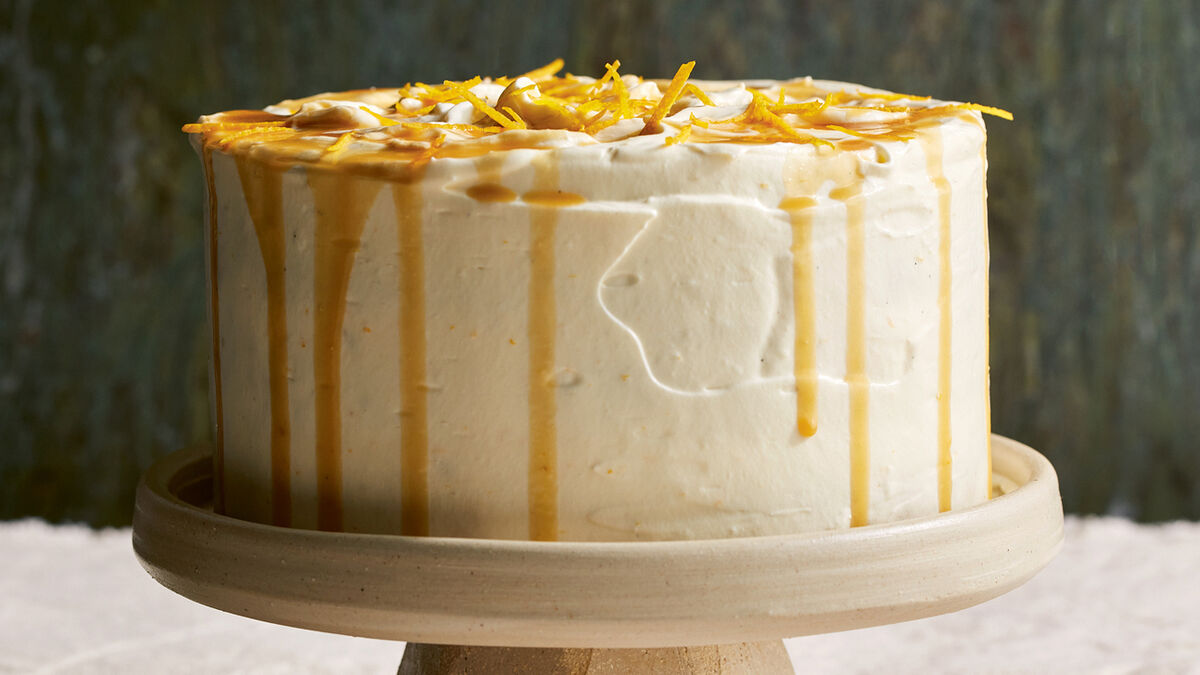
Servings
10Preparation Time
50 minsCooking Time
28 minsTotal Time
1 hours 18 minsCourse
BakingCuisine
JamaicanIngredients
For the sponge:
200ml soy milk
1tbsp cider vinegar
260g plant-based unsalted butter
210g dark soft brown sugar
100g golden syrup
100g black treacle
1½tsp vanilla bean paste
4 pieces preserved stem ginger, finely diced, plus some syrup from the jar for brushing
400g self-raising flour, sifted
¼tsp bicarbonate of soda
2tbsp ground ginger
1½tbsp ground cinnamon
For the butterscotch filling:
150ml plant-based double cream
75g light soft brown sugar
40g plant-based salted butter, cubed
1tsp cornflour, sifted
Pinch of sea salt
For the whipped cream cheese frosting:
250g plant-based cream cheese
50g caster sugar
1½tsp vanilla bean paste
Grated zest of 3 large oranges
400ml plant-based double cream
3x18cm cake tins, greased with coconut oil and lined (base and sides)
Method
Preheat the oven to 150°C fan/170°C/gas mark 3.
Add the soy milk and cider vinegar to a bowl and leave to sit for 10 minutes until lightly curdled. In the meantime, add the butter, sugar, golden syrup, treacle and vanilla bean paste to a saucepan and gently heat until the butter has melted and the sugar has dissolved. We don’t want this boiled, so take it low and slow. Remove from the heat and add the stem ginger. Give it all a good mix and set aside to cool.
In a large bowl, combine the dry ingredients with a balloon whisk. Pour in the cooled butter mix and the curdled soy milk, and mix until smooth. Divide the cake batter evenly amongst the three prepared tins. Pop in the oven and bake for 26-28 minutes until the sponge is coming away from the sides of the tins and a cocktail stick poked into the middle comes out clean.
Leave in the tins for five minutes before turning out onto a cooling rack. Leave to cool for 30 minutes before wrapping in clingfilm to cool completely. While the cakes are cooling, make the butterscotch filling. In a saucepan, add the cream, light brown sugar, butter and cornflour.
Cook over a gentle medium heat until the sugar has dissolved, the butter has melted, and the liquid begins to bubble. Take off the heat, add the sea salt (just a tiny pinch!) and give it a mix before transferring to a bowl to cool. Once cooled, pop the bowl into the fridge to firm up, which makes it easier when stacking the sponges.
Let’s get the frosting made. Into the bowl of a stand mixer, add the cream cheese, sugar, vanilla bean paste and orange zest. Mix using the whisk attachment until smooth. Pour in the double cream and mix on a slow-medium speed until the cream nearly hits stiff peaks. Transfer to a piping bag and place in the fridge for at least 30-45 minutes before using.
Once the sponges are cool, trim off any domed tops with a serrated knife before using a pastry brush to brush the tops of each sponge with syrup from the stem ginger jar.
Now it’s time to construct the cake by placing one sponge onto your serving board (you can use some cream here to glue the sponge to your serving plate). Pipe an even layer of cream over the sponge before using the back of a spoon to create a dip in the middle to add a generous slathering of the butterscotch filling. Repeat with the remaining sponges before covering the entire cake with the remaining cream. You can go as fancy as you like with the decoration or opt for a naked finish.
Place the cake in the fridge to set for at least an hour before slicing and serving with a good drizzle of any remaining butterscotch sauce.
- by Ruby Bhogal is published by Pavilion Books, priced €37. Photography by Matt Russell. Available now.


